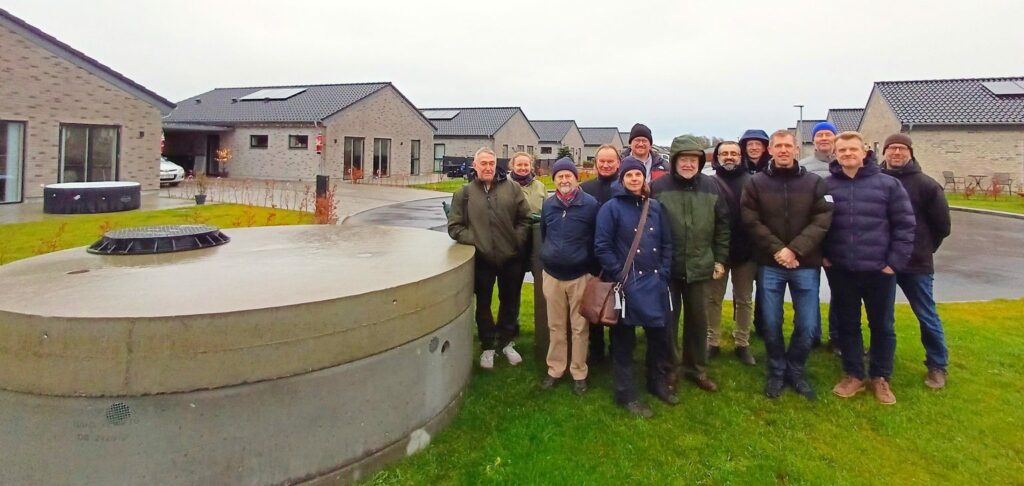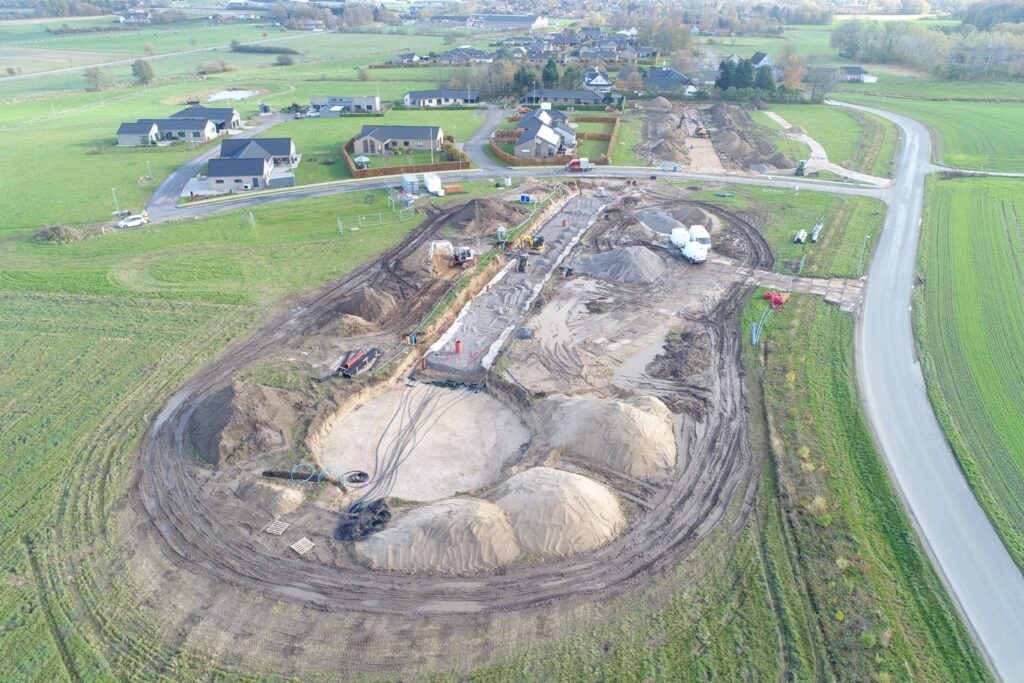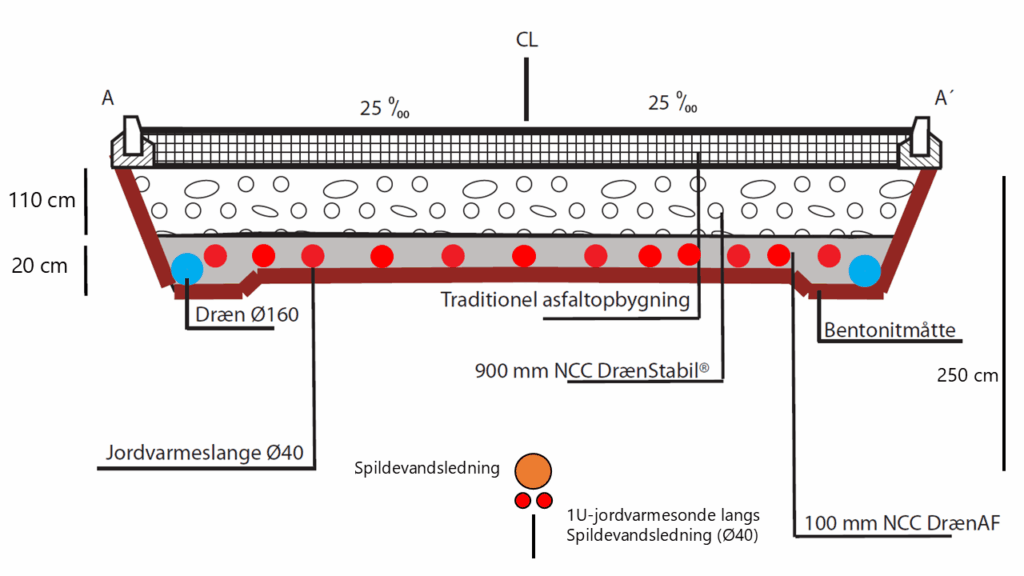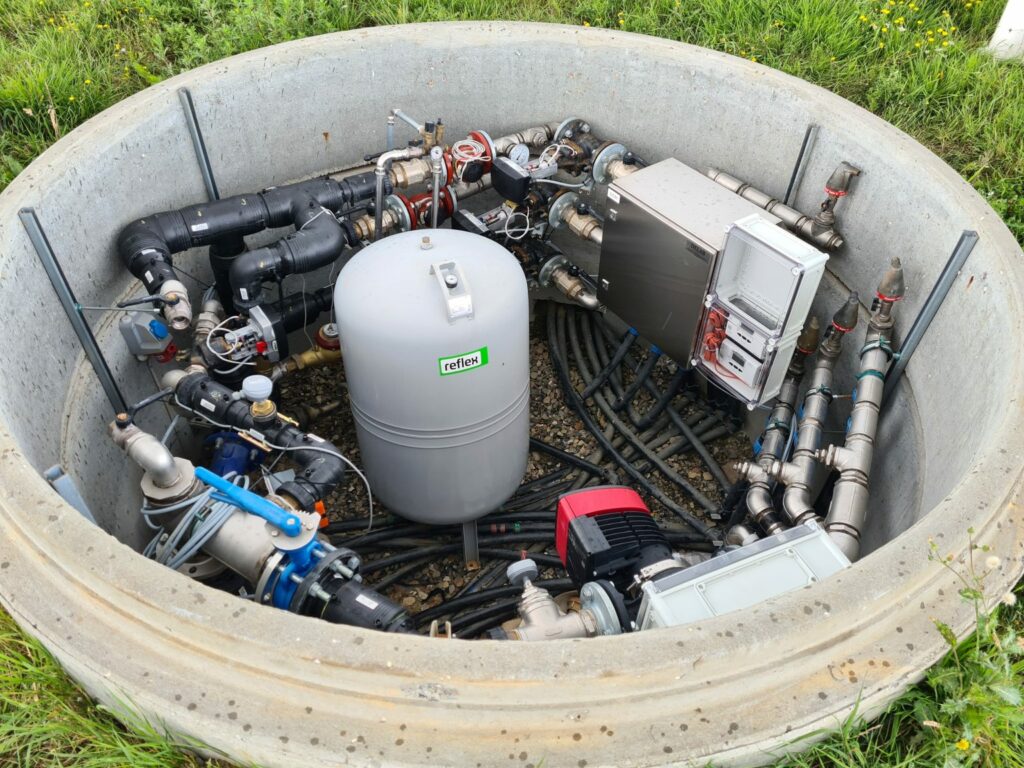

It is now possible to build roads that act as energy sources for a thermonet, delivering heating and cooling to the houses along the road. At the same time, the road structure functions as a subterranean stormwater reservoir, protecting against flooding from extreme rainfall.
This new type of road, a so-called thermo-road has been constructed and is now operational in a terraced housing development in Hedensted Municipality, Denmark. The project is the result of collaboration between Hedensted Municipality and seven public and private partners and is supported by the Danish Energy Technology Development and Demonstration Programme (EUDP).
The aim of the project has been to demonstrate how local sustainability can be increased in new-build developments in relation to energy supply and climate adaptation.
The Thermo-road is located on Vestergårdsmarken in Hornsyld, with 12 houses connected. Heating and cooling are extracted from the road structure, from the road’s sewer pipe, and from three vertical closed-loop geothermal boreholes placed at the dead end of the road. The thermonet, situated on one side beneath the road, links the houses, each of which has a small, energy-efficient geothermal heat pump installed.
In the event of extreme rainfall, large volumes of stormwater are stored in the road structure. Built with stable drainage material, the structure is dimensioned to detain water equivalent to a current 100-year rainfall event or more.
The detained stormwater can subsequently be released into the main sewer system in controlled amounts, thereby relieving pressure on the public drainage infrastructure.
Heating and cooling from the ground
Residents began moving into the houses in 2024, and already the thermo-road is showing promising results. Initial measurements confirm a very low electricity consumption for operating the geothermal heat pumps.
Geologist and project manager Associate Professor Dr Søren Erbs Poulsen from VIA University College says: “We are seeing COP values above 4.0, even before the system has been optimised. This corresponds to an electricity use more than 30 percent lower than that of air-to-water heat pumps.”
When the cooling function becomes operational, the houses’ floors can be kept cool during summer. Electricity consumption for cooling is expected to be around one-tenth that of a conventional air conditioning unit. Cooling is passive, achieved solely by circulating water at ground temperature through underfloor pipes via the thermonet.
| Thermo-road heat pumps deliver high output A heat pump’s electricity consumption reflects how many kW of heat it produces per kW of electricity used. This is expressed by the heat pump’s Coefficient of Performance (COP). According to the Danish Energy Agency’s technology catalogue, the average COP for an air-to-water heat pump is 3.0, and 3.2 for ground source heat pumps. Measurements on the Thermo-road from October to December 2024 show that the geothermal heat pumps operate with high energy efficiency, delivering COP values well above 4.0 even before full system optimisation. Measurements also revealed a very low COP in one house due to incorrect installation. The geothermal heat pumps have a maximum capacity of 4 kW, matching the size of the 118 m² houses. The heat pumps can deliver heating as well as passive and active cooling. They are configured to provide passive cooling only, with very low electricity consumption. This is achieved by the pump’s internal circulation pump running on demand in each house. |
In Denmark, cooling needs are rising
Residents in newer, well-insulated Danish homes increasingly experience a need for comfort cooling in summer. A 2015 study from Aalborg University showed that 32% of residents in newer energy-efficient homes experienced discomfort due to high indoor temperatures on a weekly basis.
The future need for comfort cooling is generally underestimated in Denmark. Forecasts suggest that Denmark could face southern European summer temperatures by mid-century. The latest research indicates that the number of cooling degree days in Denmark will increase by 24 percent if global average temperatures rise from the Paris Agreement’s 1.5°C target to a 2.0°C scenario.
Søren Erbs Poulsen says: “Thermonets are an obvious solution for meeting the growing demand for comfort cooling in Denmark. By utilising shallow geothermal energy, it is possible to supply both heating and cooling with low and flexible electricity consumption. That makes it logical to establish roads with built-in thermonets in future energy-efficient new builds requiring comfort cooling.”
He continues: “With the Thermo-road project, we have shown how this can be achieved in terraced housing, while at the same time avoiding to have to establish a separate stormwater basin. In addition, the use of geothermal heat pumps eliminates the aesthetic and noise issues associated with air-to-water heat pumps.”
New insights into operation and economics of thermo-roads
One of the aims of the received EUDP support is to generate new knowledge that can help reduce the cost and complexity of future thermo-roads.
Søren Erbs Poulsen explains: “In the Thermo-road project, we deliberately oversized the heating and cooling capacity because we currently lack precise data for dimensioning. We need more knowledge about the extent to which we can extract cooling from the road structure in summer, as it heats up significantly due to the dark asphalt. We expect to clarify this over the next 1–2 years through continued measurements.”

Once the Thermo-road has a stable and predictable performance, surplus capacity from the vertical geothermal boreholes should make it possible to connect additional houses in the adjacent area.
The Thermo-road project is a second-generation solution, building on lessons learned from The Climate Road (Klimavejen), a similar but smaller pilot project in Hedensted Municipality. The Thermo-road project has further developed expertise in crossing property boundaries and supplying an entire road with heating and cooling.
Restructuring the project half-way through
The Thermo-road project began in 2020. The original plan was for Hedensted Municipality to subdivide the area into six individually owned house plots that were put up for sale. When land sales stalled, partly due to rising interest rates in 2022, the project had to be restructured.
The project partners succeeded in finding a local company, GS Bolig, which in 2023 purchased the whole area and all infrastructure from the municipality and has since built 12 smaller houses for rental. All units are currently let.
Rules for stormwater basins should be amended to include thermal roads
One conclusion of the project is that thermo-roads offer clear advantages for stormwater management. The road structure can retain large volumes of stormwater, allowing for increased building density.
It is concluded that thermo-roads can be applied at scale. There is, in principle, no size limit for such systems as long as the terrain has a steady gradient.
Thermo-roads also contribute to climate adaptation in the surrounding areas. The constructed thermo-road can handle more than 70 mm of rain over 24 hours (extreme rainfall). To ensure even discharge, drainage pipes in the road structure lead to a flow restrictor where the road connects to the main stormwater pipe.
Building a thermo-road is more expensive than building a conventional road. The depth of the road structure increases from the standard 80 cm to 130 cm. This raises excavation and soil disposal costs. Additional costs include stable drainage material, bentonite mats to retain water in the road structure, and extra coordination and consulting services.
As the thermo-road concept is new, the road cannot yet be approved as a stormwater basin. The critical issue is whether rainwater is cleaned as effectively in a thermo-road as in a conventional basin. Søren Erbs Poulsen says: “Initial indications from a PhD study at Aalborg University suggest that a thermo-road cleans stormwater just as well as a conventional stormwater basin.” If future approvals allow thermo-roads to replace conventional basins, the economics of such projects will improve.
Configuration of the thermonet
Geothermal energy is harvested from three vertical 85-metre-deep boreholes, each with a closed double-pipe thermal probe, and from 1,200 metres of horizontal ground loops in the road structure at around 130 cm depth. In addition, the thermonet itself includes around 380 metres of ground loops. A further 100-metre thermal probe runs horizontally beneath the central sewer pipe at a depth of about 250 cm. This extracts heat from the surrounding soil, where warm wastewater from bathing, washing, etc., flows.

The road structure is hydraulically separated from the surroundings by a bentonite membrane. The thermail horizontal probe at the bottom collects thermal energy from rainwater, which keeps the lower part of the structure permanently saturated, increasing energy uptake.
The ground loops, the probe under the sewer, and the geothermal boreholes are connected to a large manifold chamber located at the end of the road. Its 2.5-metre diameter is required for the pilot project, as it houses dynamic valves, energy meters, and temperature sensors to collect detailed operational data. In a commercial-scale solution, the chamber could be omitted or significantly reduced and placed underground.

The thermonet’s supply and return lines originate from the chamber. The two main pipes run along one side of the road. From here, six service pipes each supply two houses.
An additional benefit arises during summer cooling: heat from the houses is transferred into the road structure and vertical boreholes, where it remains and enhances efficiency when the system provides heating in winter. The entire system thus uses the ground as a battery for seasonal thermal energy storage.
Project financing
The project is financed by the partners and the Danish Energy Technology Development and Demonstration Programme (EUDP), administered by the Danish Energy Agency. When GS Bolig purchased the plots, it took over the energy infrastructure from Hedensted Municipality, and GS Bolig also owns the heat pumps installed in the rental homes. Tenants pay for the electricity their heat pumps consume, while thermal energy from the road system is included in the rent.
Key Learnings
The project has demonstrated sector coupling with synergies between thermal supply and stormwater management and shows that thermal roads impose a smaller load on the electricity grid compared to air-to-water heat pumps. Key learnings include:
- The loops in the road structure that extract geothermal energy receive thermal input from fresh rainwater. Constant contact with water at the bottom of the structure enhances energy uptake and overall efficiency. This effective energy harvesting means that a system can have a smaller heat extraction area compared to a heat extraction area in soil only. Alternatively, the higher source temperature of a similar sized heat extraction area will improve winter efficiency of the heat pumps.
- Modelling shows that seasonal heat storage can be achieved via summer cooling, significantly increasing energy supply capacity in winter. This reduces initial investment in geothermal sources and/or increases heat pump efficiency, lowering electricity use.
- The project includes two new types of utility systems in the road structure, and it demonstrates that such combined solutions are practically feasible. The construction of the Thermo-road was completed on schedule in 12 weeks and encountered no unforeseen problems. Despite the added complexity, the project faced no practical obstacles, largely thanks to competent planning consultancy and high-quality construction work.
EUDP Project Partners
VIA University College in Horsens initiated and led the project.
Hedensted Municipality handled planning approvals and participated in development and sale of the site.
Geodrilling acted as consultant, delivered the thermonet solution, and managed drilling of the geothermal boreholes via subcontractor.
Hedensted Wastewater Utility helped develop the project and permitted heat recovery beneath the central sewer pipe.
Løsning District Heating initially assessed future options for operation and ownership and installed a concentrator in a flagpole to collect wireless data from the energy and electricity meters.
PlanEnergi contributed best practice knowledge and conducted the cost analysis of capital and operating expenses.
NCC provided expertise on road structure and supplied the stable drainage materials (DrænStabil and DrænAF, both with 30% porosity) and road asphalt.
Energy Machines designed and controlled the manifold chamber components.
Other Actors
HakaGerodur has supplied thermal probes for the vertical boreholes and for collecting thermal energy from the wastewater pipeline.
Dantonit has supplied the grout used to fill the geothermal boreholes.
GS Bolig purchased the plots and thermal road infrastructure from Hedensted Municipality and built the 12 rental homes.
Land & Plan served as planning consultants and supervised site preparation.
HTN Entreprenør built the road.
Varup Termiske Boringer drilled the vertical geothermal boreholes.
Kemic Vandrens created a 3D drawing of the manifold chamber.
Kamstrup supplied meters for the chamber and houses.
Frese supplied dynamic valves to control energy sources.
Bravida assembled the manifold chamber and thermonet.
Bråskovgård Efterskole allowed installation of a local weather station, also used for teaching purposes.
Salling Plast supplied pipes for the thermonet, among these PE pipes with PP casing from Uponor.
NID delivered traffic-load bearing chamber covers with designs indicating collective supply lines.
Metro Therm supplied 4 kW Metro Delta heat pumps using R290 (propane), a natural refrigerant with very low climate impact.
Danfoss supplied an underfloor heating and cooling control system that enables the floors of the houses to provide heating during the winter and cooling during the summer.
More Information About the Project
The project’s final report contains detailed descriptions of the completed Thermal Road and the research and development activities undertaken:
See also:
Project profile at EUDP: Denmark’s first thermal road is being built at Vestergårdsmarken in Hornsyld (title translated, the page is in Danish)
Abstract for conference presentation organised by the European Geosciences Union (EGU)
The developer’s presentation of the homes: Exclusive detached houses in Hornsyld: Step inside a modern and sustainable home (title translated, the page is in Danish)
Media coverage and other mentions of the project
12 June 2024, KTC conference:
Future roads must be climate-resilient – Theis R. Andersen and Michael Brask (title translated, the page is in Danish)
16 November 2023, Licitationen and Energy Supply:
Ground-breaking ceremony for homes on thermal road (title translated, the page is in Danish)
15 November 2023, Hedensted Municipality:
First spade in the ground on thermal road (title translated, the page is in Danish)
13 November 2023, Horsens Folkeblad, Vejle Amts Folkeblad and Randers Amtsavis:
Unique climate plots sold – now 12 new homes are rising along a climate-adapted road (title translated, the page is in Danish)
10 November 2023, VIA University College:
Ground-breaking for world-class climate initiative (title translated, the page is in Danish)
6 November 2023, Hydrology Day:
Utilisation of energy from ground and surface water for shallow geothermal heating and cooling supply – Søren Erbs Poulsen (title translated, the page is in Danish)
15 September 2023, VIA University College:
Three days focused on geothermal energy aim to boost the green energy transition (title translated, the page is in Danish)
13 September 2021, Centre for Public-Private Innovation:
Unique thermal road tackles two climate challenges at once (title translated, the page is in Danish)
5 April 2022, Gridtech:
Climate road could turbocharge cold district heating (title translated, the page is in Danish)
20 April 2023, Horsens Folkeblad, Vejle Amts Folkeblad and Randers Amtsavis:
No buyers for the unique climate plots in Hornsyld – now the municipality must take over the geothermal system (title translated, the page is in Danish)
13 December 2021, Teknik & Miljø:
Thermo-road: The climate Kinder Egg in Hornsyld (title translated, the page is in Danish)
25 October 2021, Hedenstederne magazine:
Hornsyld: Would you take the thermo-road? (title translated, the page is in Danish)
26 April 2021, KTC:
Partners in groundbreaking energy project behind new KTC network for green transition in villages (title translated, the page is in Danish)
9 April 2021, TV Syd:
New green building plots ready for sale – live on Denmark’s first thermo-road (title translated, the page is in Danish)
26 March 2021, Horsens Folkeblad, Vejle Amts Folkeblad and Randers Amtsavis:
Sustainable housing development with climate road emerging: Hornsyld makes its mark (title translated, the page is in Danish)





